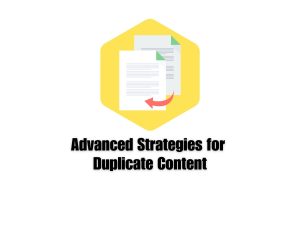
Exploring Advanced Techniques for Dealing with Duplicate Content
Duplicate content refers to identical or similar content that appears on multiple URLs within a website or across different websites. While duplicate content is common
In the realm of on-page optimization, headings play a crucial role in organizing content, improving readability, and signaling the relevance of different sections to search engines. Properly utilizing headings not only enhances the user experience but also boosts search engine visibility and rankings. In this article, we’ll delve into the importance of headings for on-page optimization and provide tips for their effective use.
Headings serve as signposts that guide readers through the content and provide structure to web pages. By breaking down content into distinct sections with clear headings (e.g., H1, H2, H3), you create a hierarchy that makes it easier for users to navigate and understand the information. Search engines also rely on headings to understand the topical relevance of different sections, which can influence rankings.
Strategically incorporating target keywords into headings can signal the topic or theme of the content to both users and search engines. The primary heading (H1) should ideally include the main keyword or keyphrase that reflects the overarching topic of the page. Subheadings (H2, H3, etc.) can then contain related keywords or variations, providing context and relevance to specific sections of the content.
Headings break up large blocks of text and make content more digestible for readers, especially those who tend to scan or skim through web pages. Descriptive and engaging headings capture attention and encourage users to delve deeper into the content. Additionally, headings help users quickly locate the information they’re seeking, improving overall readability and user experience.
From an SEO perspective, using heading effectively can have a significant impact on search engine rankings. Search engines consider the placement and frequency of keywords within heading when determining the relevance and topicality of a web page. Properly structured headings also contribute to the overall semantic clarity of the content, which can improve its chances of ranking for relevant search queries.
– Hierarchy: Follow a logical hierarchy of heading, with H1 for the main title or topic, followed by H2, H3, and so on for subtopics and subsections.
– Consistency: Maintain consistency in heading styles and formatting throughout the website for a cohesive user experience.
– Relevance: Ensure that heading accurately reflect the content of the section and incorporate relevant keywords where appropriate.
– Length: Keep heading concise and descriptive, conveying the main idea of the section without being overly verbose.
– Accessibility: Use heading to improve accessibility for users with disabilities, as screen readers rely on heading structure to navigate web content.
Incorporating headings effectively into your on-page optimization strategy can significantly enhance the user experience, improve readability, and boost search engine visibility. By structuring content with clear and relevant headings, you not only make it easier for users to consume and navigate your website but also signal its relevance and authority to search engines. By following best practices for heading usage and optimization, you can maximize the impact of your on-page content and drive better results in organic search rankings.

Duplicate content refers to identical or similar content that appears on multiple URLs within a website or across different websites. While duplicate content is common
Duplicate content refers to identical or similar content that appears on multiple URLs within a website or across different websites. While duplicate content is common





“LeadsView did an excellent job with my project and will definitely recommend. Easy to work with, flexible and good quality of work. I am more than happy to recommend them."




















Copyright 2023 © LeadsView. All Rights Reserved
